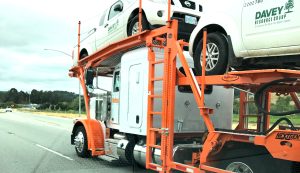Introduction To Vehicle Shipping To Honolulu
Shipping a vehicle to Honolulu is a process that requires careful planning and understanding of various logistical elements. Whether you’re relocating for work, moving closer to family, or simply seeking the island lifestyle, getting your car to Honolulu involves more than just handing over the keys. The journey includes multiple stages—from selecting the right shipping company and preparing your vehicle for transport, to understanding timelines and potential costs.
The distance between the mainland United States and Honolulu presents unique challenges for vehicle shipping. Unlike moving a car across state lines within the continental U.S., transporting a vehicle to an island in the Pacific Ocean necessitates specific modes of transit—primarily ocean freight. This method introduces variables such as port schedules, weather conditions, and shipping regulations that can impact delivery times.
Moreover, several factors influence how long it takes for your vehicle to reach its Honolulu an destination. These include the departure port on the mainland (commonly Los Angeles or Seattle), seasonal demand fluctuations, and even customs clearance processes upon arrival in Honolulu . Each of these steps must be navigated with precision to ensure timely delivery.
Understanding these intricacies can help you better prepare for what lies ahead. By grasping the essentials of vehicle shipping logistics, you can make informed decisions that alleviate stress and ensure your car arrives safely at its new island home. This guide aims to provide comprehensive insights into each phase of this complex but manageable journey, helping you navigate through it with confidence and ease.
Factors Affecting Shipping Time
Shipping a vehicle to Honolulu involves several factors that can significantly influence the overall transit time. One of the primary considerations is the point of origin. Vehicles shipped from the West Coast, such as Los Angeles or San Francisco, typically have shorter transit times compared to those coming from farther inland or the East Coast due to proximity and established shipping routes.
Another critical factor is the chosen method of shipping. Roll-on/roll-off (RoRo) services, where vehicles are driven onto a specialized vessel, might offer faster loading and unloading times compared to container shipping, where vehicles are packed into containers for added protection but may require more handling and scheduling coordination.
Seasonality also plays a crucial role in determining shipping duration. Peak seasons often lead to increased demand for shipping services, which can result in longer wait times for available space on vessels. Conversely, off-peak periods might offer quicker turnaround but could also see fewer scheduled sailings.
Furthermore, customs and regulatory procedures must be considered. Ensuring all paperwork is accurately completed and submitted on time can prevent delays at ports both on the mainland and upon arrival in Honolulu . This includes adhering to agricultural inspection regulations unique to Honolulu .
Lastly, weather conditions can cause unexpected delays. Rough seas or adverse weather events might slow down transit times or necessitate temporary halts in shipping operations for safety reasons.
In conclusion, while there are many variables at play when shipping a vehicle to Honolulu , understanding these factors can help set realistic expectations regarding delivery timelines and allow for better planning throughout the process.
Different Shipping Methods Available
When it comes to shipping a vehicle to Honolulu , there are several different methods available, each catering to various needs and preferences. The two primary options are roll-on/roll-off (RoRo) shipping and container shipping. Understanding the nuances of these methods can help you make an informed decision that best suits your circumstances. Roll-on/roll-off (RoRo) shipping is often the most straightforward and cost-effective method for transporting vehicles.
In this process, cars are driven onto a specialized ship designed for carrying wheeled cargo. This method is highly efficient for standard vehicles like sedans, SUVs, and trucks. RoRo vessels have ramps that allow vehicles to be easily rolled on at the port of departure and off at the destination port in Honolulu . One key advantage of RoRo shipping is its simplicity; however, it does expose your vehicle to the elements during transit.
Container shipping offers a more secure but potentially more expensive alternative. In this method, your vehicle is loaded into a large metal container which is then placed on a ship bound for Honolulu . This option provides additional protection from weather conditions and potential damage during transit since the car is enclosed within a sturdy container. Container shipping can be particularly beneficial if you need to transport additional belongings along with your vehicle or if you own a luxury or classic car that requires extra care.
Additionally, some companies offer door-to-port services where they pick up your vehicle from your home and transport it directly to the departure port, adding another layer of convenience albeit at an extra cost.
Average Shipping Duration By Method
Shipping a vehicle to Honolulu involves a range of logistical considerations, and one of the most critical aspects is understanding the average shipping duration based on the method employed. The two primary methods for transporting vehicles to Honolulu are via ocean freight and air freight, each offering distinct timelines and advantages.
Ocean freight is the most commonly used method due to its cost-effectiveness. When opting for this route, vehicle owners can expect an average shipping duration of about 2 to 3 weeks from the mainland United States to Honolulu . This timeline includes several stages: initial booking and scheduling, transport to the port of departure, loading onto a cargo ship, transit time across the Pacific Ocean, unloading at a Honolulu an port, and finally preparation for customer pickup or delivery.
Factors such as weather conditions and port congestion can also influence this timeframe.
In contrast, air freight provides a significantly faster option but at a higher cost. Shipping a vehicle by air typically takes between 1 to 5 days from departure to arrival in Honolulu . This expedited service is ideal for those who require their vehicle urgently or have high-value cars that necessitate special handling. Despite its speed, air freight requires meticulous planning due to limited aircraft capacity and stringent regulatory requirements.
Ultimately, choosing between ocean and air freight depends on budget constraints, urgency of need, and specific preferences regarding convenience or care level for the vehicle during transit. Understanding these factors helps in making an informed decision that aligns with individual priorities while ensuring timely delivery of one’s vehicle in Honolulu .
Preparing Your Vehicle For Shipping
Preparing your vehicle for shipping to Honolulu involves several crucial steps to ensure a smooth and hassle-free process. Firstly, it is essential to clean your car thoroughly, both inside and out. A clean vehicle allows for a more accurate inspection, helping to document any pre-existing damage and ensuring that the car arrives in the same condition as it was sent.
Next, remove all personal items from the vehicle. Shipping companies generally prohibit personal belongings in the car during transit for safety and insurance reasons. Additionally, these items can add unnecessary weight, potentially increasing shipping costs or causing delays.
After cleaning and clearing out the interior, conduct a thorough mechanical check-up of your vehicle. Ensure that fluid levels are appropriate and there are no leaks or mechanical issues that could worsen during transport. It’s also advisable to have less than a quarter tank of gas in your vehicle to reduce weight and comply with safety regulations.
Documenting the current state of your vehicle is another important step. Take detailed photographs from multiple angles, capturing any existing dents, scratches, or other damages. These images will be valuable if you need to file an insurance claim later on.
Finally, disable any alarm systems in your vehicle before shipping it off. An active alarm can be triggered during transit due to movement or vibrations, potentially leading to complications or delays in delivery.
By following these preparatory steps diligently, you can help ensure that shipping your vehicle to Honolulu is as seamless as possible while minimizing risks of damage or delays along the way.
Documentation And Legal Requirements
When shipping a vehicle to Honolulu , understanding the documentation and legal requirements is crucial to ensure a smooth and hassle-free process. The first essential document is the title of the vehicle, which must be under your name. This serves as proof of ownership and is necessary for both shipping companies and Honolulu an authorities. If there’s a lien on the vehicle, you’ll also need written permission from the lienholder.
Additionally, you will require a valid photo ID, such as a driver’s license or passport. This ID confirms your identity and matches it with the details on the title of the vehicle. Another critical document is an up-to-date registration for your car, confirming that it is currently registered in your state of residence.
Insurance documentation must also be provided to cover any potential damages during transit. Although most shipping companies offer insurance coverage, having your own policy can add an extra layer of security.
For vehicles financed through loans or leases, obtaining explicit permission from the financial institution or leasing company before shipping is mandatory. This consent often requires completing specific forms that authorize transportation out-of-state.
In terms of legal compliance upon arrival in Honolulu , you must pass a safety inspection within 30 days to register your vehicle locally. Failure to comply with this requirement can result in fines or penalties. You’ll also need proof of Honolulu an auto insurance before registration.
Understanding these documentation and legal requirements will help streamline your vehicle’s journey from mainland U.S.A. to Honolulu , ensuring all regulatory boxes are checked well in advance.
Choosing A Reliable Shipping Company
When considering how long it takes to ship a vehicle to Honolulu , selecting a reliable shipping company is crucial. The right company can significantly impact not only the timeline but also the overall experience of transporting your vehicle across the Pacific. First and foremost, reputation matters. Research potential companies by reading reviews and testimonials from previous customers. Look for feedback on their timeliness, customer service, and how they handle issues that may arise during the shipping process.
A company with a strong track record is more likely to deliver your vehicle on schedule and in good condition. Experience is another key factor. Companies that have been in the business for several years are generally more adept at navigating the complexities of maritime transport. They often have established relationships with port authorities and understand the intricacies of customs regulations, which can expedite the process.
Insurance coverage is also vital when choosing a shipping company. Ensure that they offer comprehensive insurance policies that cover potential damages during transit. This provides peace of mind knowing that you’re protected financially should anything go wrong. Customer service shouldn’t be overlooked either. A reliable shipping company will offer clear communication channels and provide regular updates on your vehicle’s status throughout its journey.
They should be readily available to answer any questions or concerns you might have, ensuring transparency from start to finish. Lastly, consider their logistical capabilities such as pick-up services from your location and delivery options once the vehicle arrives in Honolulu . A company offering door-to-door service can save you time and hassle compared to those requiring drop-off at specific terminals.
Tracking And Receiving Your Vehicle In Honolulu
Once your vehicle is en route to Honolulu , the anticipation of its arrival can be both exciting and nerve-wracking. Understanding the tracking and receiving process can help alleviate some of that anxiety. Most shipping companies provide a tracking number or an online portal where you can monitor the progress of your vehicle as it makes its way across the ocean. This real-time tracking system allows you to see updates at various transit points, giving you a clearer idea of when your car will arrive.
Upon the vessel’s approach to Honolulu , you’ll typically receive a notification from the shipping company with an estimated date and time for pickup. It’s crucial to stay in close communication with them during this period, as schedules can sometimes shift due to weather conditions or other unforeseen delays.
Once the ship docks at one of Honolulu ‘s major ports—such as Honolulu, Hilo, or Kahului—the vehicle will go through a brief customs inspection if it’s coming from outside the United States. After clearing customs, you’ll need to present proper identification and any necessary documentation provided by your shipping company before you can take possession of your car.
Finally, thoroughly inspect your vehicle upon receipt for any damage incurred during transit. Most reputable shipping companies offer insurance coverage for such instances but reporting any issues immediately is essential for smooth claims processing.
By staying informed and prepared throughout this process, you can ensure that receiving your vehicle in Honolulu goes as smoothly as possible, allowing you to enjoy island life without delay.




